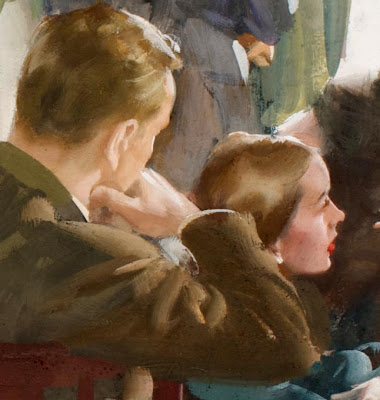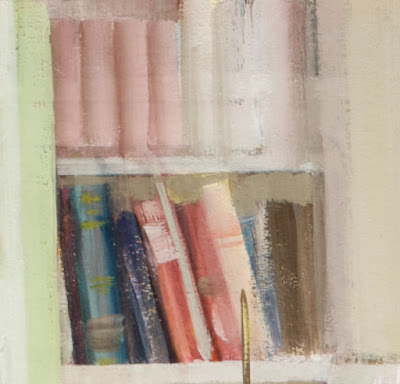
He said he used “two different colors on a single bristle brush in painting objects whose color might run from light to dark—as on a cylinder. First I load the brush with the lighter hue and then with a section of the brush I pick up the darker paint so that, when the stroke is made, very interesting accidentals result.”

“This works very well on small objects,” Anderson says. You can see Anderson’s blended-stroke method in the rendering of the bookcase, where each book’s spine was made with a minimum of strokes.

These enlarged details are from the painting “The Widow,” which appears as a double-page spread on page 10-11 of Color and Light: A Guide for the Realist Painter.
--------
Quotes from: “Harry Anderson Discusses his Painting in Tempera,” American Artist, May, 1956. (“Gouache,” “tempera,” and “opaque watercolor” are all roughly the same thing.)
Color and Light on Amazon internationally: USA | CA | UK | FR | DE | JP
Color and Light signed (and doodled in) by me, from the Dinotopia Store







11 comments:
Interesting practice.
I remember reading about that Anderson's method in an article about the artist in Illustration mag...can't remember which issue.
It was issue #12 of Illustration—actually have it open on my desk right now. I've tried this method myself, though not to such great effect. What I've always wondered was how he achieved blends on a larger scale, or even on things like the back of the man's head. Perhaps he was working wet into wet? I can't really tell without looking at an original.
I do this sometimes with oils. It often can result in a tight line blend that's more satisfying than using a fan brush with-the-grain.
When I was a kid I took decorative painting classes (folk art kind of stuff). The teacher loaded the brush with two, sometimes three colors often to come up with all kinds of different stuff. It was easier when the paint was a little thinner.
Indeed, my Dad was doing "Tole Painting" as a hobby for a few years, and this is common practice in that discipline. There are many how-to books that teach you specific techniques for specific kinds of flowers, fruits, and other objects, usually using some variation on this idea.
I'm just loving the book - great images in it! aznd I really like this one
I have a similar experience to Carolyn; my mom took me, my sister, my friend, and my cousin to take some painting classes when we were little kids; horrible class with a nice little old lady who was "trained" to teach the 'One-Stroke' method by it's brand name popularizer, Donna Dewberry (Bob Ross's niece in a metaphorical sense): http://www.dewberrycrafts.com/
Its obviously little more than decorative craft used to paint cute little fish and flowers on pots and other such knickknacks. It was cool and fun to me at the time, but afterward I was pretty against that sort of thing, loading the brush with two colors and making a transition in that way. Seemed cheap and fake to me, but I suppose that such techniques can be used to great effect--though suffice it to say that Anderson's usage of it was a tad more sophisticated.
Beautiful illustration!! I use gouache a lot, so this is really helpful! By the way, Your book color and light has the subtitle : A guide for the realist painter'. I think it is important to mention that the book offers insights in how color and light work. this knowledge may be applied to stylized illustration as well as to a realist approach.
My reaction was similar to Daniel's, Ernests's and Carolyn's -linking this to tole/craft painting. Like Daniel, I had a sort of visceral negative response...but why, wonder? I think the difference in the use of this technique is that in the hands of Anderson, this is a tool in the service of a person with obvious skill. It is a means to an end, whereas in crafts this means is so close to the "end" as to be the "end" itself...if that makes any sense.
I'm also reminded of a description of Sargent painting the pearls on a necklace in such a fashion. No way I'm quibbling with him!
Bob Ross would often use a blended stroke method in his paintings with a filbert brush, especially as a quick means of highlighting or shading a tree trunk.
Double loading, triple loading, and more, are common in shui mo hua - Chinese ink painting, in colour. The video at the top of the page on my blog shows me loading several watercolours onto the one waterbrush. Two and three tone brush loading techniques are common when working with black ink in both Chinese shui mo hua and Japanese sumi-e.
I find double loading is very conducive to describing more with fewer strokes (saying more with less), which helps with the all important concealment of artifice that makes for a fresh, engaging, lively painting.
Cole is right, definitely it is a nice transposition of a very common technique in oriental painting.
The results of the brushstrokes in these illustrations are outstanding anyway.
By the way, today I just ordered my copy of your Light and color, can't wait to have it. Santa won't bring it, that's for sure, but perhaps the Three Wise Men will.
All the best for Xmas and new year!
Post a Comment